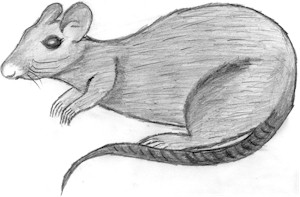


Importance
of Rats
The Rat was the miners best friend. The rat could cause the miners death if he were not careful but he also played a very important role in the survival of the miner. The mines were full of rats but the miners never tried to get rid of them. These rats were different than the rats seen around houses. As one local miner described them nicely - "they had a big arse and a small head" so that gives you the picture.
Warnings
If the mines were about to collapse or flood the rats would run out in their hundreds. This could be a day or more before the actual collapse or flood but the rats could sense it. They would hear the movement in the walls or feel the oncoming water. Often as a miner dug into the wall of a mine there could be an underground lake just behind that wall looking for a weak spot to burst out and flood the mine. The little rat therefore helped to avoid many tragedies. When the miners saw the rats heading out, they quickly followed them.
Dangers
As important as the rat was to the miner he also posed a very dangerous threat. The rat was forever watching the miners lunch and given half a chance he would run out and snatch the lunch. They were cheeky little fellows and had no fear whatsoever of the miners. If the rat came into contact with the lunch by urinating on it or by just touching it and if the miner subsequently ate the lunch he could die or get very sick from one of the many diseases carried by the rat. For this reason the miner kept his lunch in a metal box called a "piece box". Some miners did not have a piece box and just wrapped their lunch in paper. They would usually hang it by a string from the roof of the mine. However, some smart rats could find a way round that problem, chew on the string and then enjoy a lunch of egg, turnip, potato or maybe even rasher sandwiches.
Weils Disease
Several crystal clear streams ran through the mines. The miner would often be working in extremely warm and stuffy conditions. However, he could not give in to the temptation of drinking this water as it was likely that rats may have urinated in it and on drinking it the miner would catch the deadly "Weils Disease". He would later die a very painful death. A bite from a rat would give you the same disease.
Call of Nature
The miner was often
working 3 miles from the surface for maybe 8 or 12 hours at a time. Where
did he go to the toilet? It could take him an hour to make his way back to
the surface!
The miners went to the toilet in "worked out roads" which were
called the "gobbin roads". Needless to say, these were not very
pleasant places to be. If there was an underground flooding, which there
often was, you can imagine what it was like if the flood came down one of
the "gobbin roads" and washed out into the area you were working
in! The rat helped out here. It is not very nice to talk about but the
rats actually ate the "human excrement" (what you leave behind
you when you go to the toilet). This helped greatly to keep the mines
clean to some extent. Can you imagine "lunch time" in the mines.
Maybe 100 miners would leave the small road they were working on and
come out to the big road where they would all be sitting down in a row
using a board or something similar (called lids) to sit on and so keep
their backsides dry. Having been sweating all morning they would need to
throw an old coat or a sack over their shoulders to keep themselves from
getting a cold.
Friends for Ever
So the Rat and the Miner got on very well together. They helped each other, the miner indirectly feeding the rat and the rat helping to keep the miner safe.


